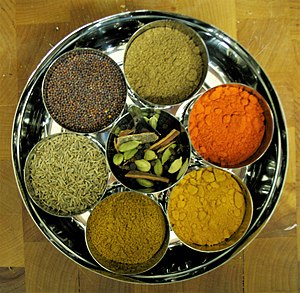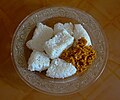South Asian cuisine/ja: Difference between revisions
Created page with "南アジア料理" |
No edit summary |
||
| (31 intermediate revisions by the same user not shown) | |||
| Line 1: | Line 1: | ||
<languages /> | <languages /> | ||
{{Short description|南アジアの食の伝統}} | |||
{{Short description| | [[File:South Asia (orthographic projection) without national boundaries, with ambiguities indicated.svg|thumb|南アジアの正射図法]] | ||
[[File:South Asia (orthographic projection) without national boundaries, with ambiguities indicated.svg|thumb| | '''南アジア料理'''には、現在の[[:en:Bangladesh|バングラデシュ]]、[[:en:India|インド]]、[[:en:Maldives|モルディブ]]、[[:en:Nepal|ネパール]]、[[:en:Pakistan|パキスタン]]、[[:en:Sri Lanka|スリランカ]]といった[[:ja:南アジア|南アジア]]諸国、そして時には[[:en:Bhutan|ブータン]]王国や[[:en:Afghanistan|アフガニスタン]]首長国も含む伝統的な[[cuisine/ja|料理]]が含まれる。'''デシ料理'''とも呼ばれ、[[:en:Indian subcontinent|インド亜大陸]]以外の[[Asian cuisine/ja|アジア料理]]にも影響を与え、また影響を受けてきた。 | ||
''' | |||
== 主食と一般的な食材{{Anchor|Staples and common ingredients}} == | |||
== Staples and common ingredients == | [[File:Indianspicesherbs.jpg|thumb|様々なスパイスとハーブ。スパイスはインド亜大陸の多くの地域で不可欠な食材である。]] | ||
[[File:Indianspicesherbs.jpg|thumb| | [[chapati/ja|チャパティ]]という[[flat bread/ja|平たいパン]]は、インド亜大陸の多くの地域で一般的な食事の一部である。他の多くの料理の主食には、米、[[atta flour/ja|アタ粉]]で作られた[[roti/ja|ロティ]]、豆類などがある。 | ||
[[ | |||
この地域の料理は、様々な種類の唐辛子、黒胡椒、クローブ、その他の強いハーブやスパイス、そして風味付けされたバターである[[ghee/ja|ギー]]で味付けされている。生姜は、この亜大陸の料理では、風味豊かな料理にも甘い料理にも使うことができる食材である。刻んだ生姜は肉と一緒に炒められ、生姜のピクルスはよく炊いたご飯に添えられる。生姜汁やシロップで煮た生姜はデザートを作るのに使われる。ウコンとクミンはカレーによく使われる。 | |||
一般的な肉には、ラム、ヤギ、魚、鶏肉、そして[[beef/ja|牛肉]]が含まれる。牛は[[:en:Hinduism|ヒンドゥー教]]で特別な位置を占めるため、[[:en:India|インド]]では他の南アジア料理に比べて牛肉は一般的ではない。牛肉の禁止は、ある程度(水)[[:en:water buffalo|水牛]]や[[:en:yak|ヤク]]の肉にも及ぶ。[[Pork/ja|豚肉]]は、すべてのムスリムにとって[[Taboo food and drink/ja|タブーな食べ物]]とされており、多くのヒンドゥー教徒にはタブーではないが避けられている(ただし、[[:en:Northeast India|北東インド]]や[[:en:Goa|ゴア]]など一部の地域では一般的に食べられている)。[[dairy product/ja|乳製品]]を使った非常に甘いデザートも、インド亜大陸の料理には多く見られる。インド亜大陸のデザートの主な材料は、煮詰めた牛乳、挽いたアーモンド、レンズ豆の粉、ギー、砂糖である。[[Kheer/ja|キール]]は乳製品ベースのライスプディングで、一般的なデザートである。 | |||
== 歴史{{Anchor|History}} == | |||
== History == | {{main/ja|History of Indian cuisine/ja}} | ||
{{main|History of Indian cuisine}} | この亜大陸の多くの食べ物は、5000年以上にわたって知られてきた。インド亜大陸の北西部に定住したインダス文明の人々は、カメやワニを狩っていた。彼らはまた、野生の穀物、ハーブ、植物も採集していた。インダス時代(紀元前3300年~1700年頃)の多くの食べ物や食材は、今日でも一般的である。それらには、小麦、大麦、米、タマリンド、ナス、キュウリなどがある。インダス文明の人々は、油、生姜、塩、青唐辛子、そして乾燥させてオレンジ色の粉にしたウコンの根を使って調理していた。 | ||
インドの人々は、歴史を通じて葉物野菜、レンズ豆、ヨーグルトやギーなどの乳製品を使ってきた。また、クミンやコリアンダーなどのスパイスも使用した。インド原産の黒胡椒は、紀元400年頃には頻繁に使われていた。ギリシャ人はサフランをもたらし、中国人はお茶を紹介した。[[:en:Portuguese people|ポルトガル人]]と[[:en:British people|イギリス人]]は、紀元1700年以降に赤唐辛子、ジャガイモ、カリフラワーを普及させた。1200年以降にインドに到着し始めた[[:en:Mongols|ムガル人]]は、食を芸術と見なし、彼らの料理の多くは25種類ものスパイスを使って調理されている。彼らはまた、ローズウォーター、カシューナッツ、レーズン、アーモンドも使用した。 | |||
18世紀後半から19世紀初頭にかけて、スコットランドの[[:en:Robert Lindsay (Sylhet)|ロバート・リンゼイ]]の自伝には、[[:en:Sylhetis|シレット人]]のサイード・ウラーという男性がリンゼイの家族のためにカレーを料理したことが記されている。これはおそらく、[[:en:United Kingdom|イギリス]]におけるインド料理の最も古い記録である。 | |||
<gallery widths="200" heights="200"> | <gallery widths="200" heights="200"> | ||
Bhang eaters before two huts (6124556163).jpg|[[Bhang]] | Bhang eaters before two huts (6124556163).jpg|1790年頃のインドの[[Bhang/ja|バングー]]を食べる人々。バングーは、インド亜大陸原産の[[cannabis (drug)/ja|大麻]]の[[cannabis edible/ja|食用調製品]]である。紀元前1000年にはすでに[[:en:ancient India|古代インド]]の[[:en:Hindu|ヒンドゥー教徒]]によって飲食物に用いられていた。 | ||
Nimmatnama-i Nasiruddin-Shahi 283.jpg| | Nimmatnama-i Nasiruddin-Shahi 283.jpg|珍味とレシピの書である''[[Wikipedia:Nimatnama-i-Nasiruddin-Shahi|Nimatnama-i-Nasiruddin-Shahi]]''のページ。[[kheer/ja|キール]]を作る優れた技法が記録されている。 | ||
Sweets 1.jpg|[[Medieval India]] | Sweets 1.jpg|[[:en:Medieval India|中世インド]]の写本『ニマトナーマ・イ・ナスィールッディーン・シャーヒー』(16世紀頃)に[[samosa/ja|サモサ]]が供されている様子が描かれている。 | ||
</gallery> | </gallery> | ||
==文化別{{Anchor|By culture}} == | |||
==By culture== | ===アフガニスタン料理 === | ||
=== | {{main/ja|Afghan cuisine/ja}} | ||
{{main|Afghan cuisine}} | アフガニスタン料理は、アフガニスタンが[[:en:Persian|ペルシャ]]、[[:en:Central Asian|中央アジア]]、[[:en:Indian|インド]]の各文化圏と近接し、文化的つながりがあるため、それらの料理の影響を受けている。この料理は[[halal/ja|ハラール]]であり、主に[[mutton/ja|羊肉]]、[[beef/ja|牛肉]]、[[poultry/ja|家禽]]、[[fish/ja|魚]]を[[rice/ja|米]]や[[Naan/ja|アフガニスタンパン]]と共に食する。 | ||
<gallery class="center"> | <gallery class="center"> | ||
File:Afghan Palo.jpg| | File:Afghan Palo.jpg|アフガニスタンの''[[Kabuli palaw/ja|カブリ・パラウ]] | ||
File:Afghan Ashak dumplings.jpg| | File:Afghan Ashak dumplings.jpg|アフガニスタンの''アウシャク'' | ||
File:Afghani lamb kebab.jpg| | File:Afghani lamb kebab.jpg|[[saffron/ja|サフラン]]イエローライス添えアフガニスタンラムケバブ | ||
File:Afghan Bolani.jpg|[[Bolani]] | File:Afghan Bolani.jpg|[[Bolani/ja|ボラニ]] | ||
File:Bread of Afghanistan in 2010.jpg| | File:Bread of Afghanistan in 2010.jpg|地元のパン屋のナン(パン)。アフガニスタンで最も広く消費されているパン。 | ||
</gallery> | </gallery> | ||
===バングラデシュ料理=== | |||
{{main/ja|Bangladeshi cuisine/ja}} | |||
{{main|Bangladeshi cuisine | バングラデシュ料理はベンガル料理が主流であり、その多様な[[:en:History of Bangladesh|歴史]]と河川の多い[[:en:geography of Bangladesh|地理]]によって形作られてきた。この国は[[:en:tropical monsoon climate|熱帯モンスーン気候]]である。[[Rice/ja|米]]はバングラデシュの人々の主要な[[staple food/ja|主食]]であり、様々な種類の[[Curry/ja|カレー]]と共に供される。 | ||
[[File:Bangladeshi cuisine.png|thumb|left|伝統的なバングラデシュの食事:[[Mustard seed/ja|マスタードシード]]と[[Ilish/ja|イリッシュ]]の''カレー''、ダッカ風''[[Biryani/ja|ビリヤニ]]''、''[[Pitha/ja|ピタ]]'']] バングラデシュ料理は強い[[:en:aromatic|芳香]]を特徴とし、しばしば[[Egg (food)/ja|卵]]、[[potatoes/ja|ジャガイモ]]、[[tomatoes/ja|トマト]]、[[aubergines/ja|ナス]]を含む。バングラデシュ料理では、様々な種類の[[spices/ja|スパイス]]と[[herbs/ja|ハーブ]]が、[[mustard oil/ja|マスタードオイル]]や[[ghee/ja|ギー]]と共に使用される。主なパンは[[naan/ja|ナン]]、[[paratha/ja|パロタ]]、[[roti/ja|ロティ]]、[[bakarkhani/ja|バカルカーニ]]、[[luchi/ja|ルチ]]である。''[[Dal/ja|ダル]]''は2番目に重要な主食であり、米/ポロタ/ルーチと共に供される。[[Fish as food/ja|魚]]はバングラデシュ料理の主食であり、特に[[:en:freshwater fish|淡水魚]]は、この国の美食の際立った特徴である。主な魚料理には、''[[ilish/ja|イリッシュ]]''(''ヒルサ'')、''[[Ompok bimaculatus/ja|パブダ]]''(''バターフィッシュ'')、''[[rohu/ja|ルイ]]''、''[[pangas catfish/ja|パンガシュ]]''、''[[clown knifefish/ja|チトル]]''、''[[walking catfish/ja|マグル]]''、''[[barramundi/ja|ベットキ]]''、[[tilapia/ja|ティラピア]]などがある。肉の消費には[[beef/ja|牛肉]]、[[Lamb and mutton/ja|ラム肉]]、[[venison/ja|鹿肉]]、[[Chicken (food)/ja|鶏肉]]、[[Duck (food)/ja|鴨肉]]、[[Squab (food)/ja|ヒナバト]]、[[koel/ja|コエル]]が含まれる。野菜料理は、マッシュしたもの(''ボルトラ'')、茹でたもの(''サブジ'')、または葉物野菜をベースにしたもの(''[[saag/ja|サーグ]]'')が広く供される。[[Lobster/ja#As food|ロブスター]]や[[shrimp and prawn as food/ja|エビ]]などの魚介類もよく食べられる。 | |||
[[File:Bangladeshi cuisine.png|thumb|left| | |||
[[Islamic dietary law/ja|イスラム教の食の戒律]]はバングラデシュ全土で普及している。ハラール食品とは、イスラム教の食事のガイドラインに従ってムスリムが飲食を許可されている食品を指す。この基準は、許可される食品の種類と、食品の調理方法の両方を規定している。対象となる食品は、主にイスラム教で許可されている肉の種類である。バングラデシュの人々は、食事の際に特定の規則や規制に従う。これには、温かいもてなしや特定の方法での給仕も含まれる。これは''バンガリケタ''({{langx|bn|বাঙালি কেতা}})として知られている。この文化は、結婚式や夕食に人々を招待する方法も定義している。特定の機会には贈り物が贈られる。''バンガリケタ''には、食器を適切に提供する方法も含まれる。ベンガル料理は、この亜大陸で伝統的に発展した唯一の複数コースの伝統を持ち、その構造は、一斉に料理が提供されるのではなく、コースごとに提供される近代的な''[[:en:service à la russe|ロシア式給仕]]''の[[French cuisine/ja|フランス料理]]と類似している。 | |||
[[Islamic dietary law]] | |||
===ブータン料理=== | |||
{{main/ja|Bhutanese cuisine/ja}} | |||
{{main|Bhutanese cuisine}} | [[File:Bhutanese hemadatsi.jpg|thumb|ブータンの国民食''[[Ema datshi/ja|エマ・ダツィ]](ཨེ་མ་དར་ཚིལ།)''と米([[Bhutanese red rice/ja|ブータン赤米]]と[[white rice/ja|白米]]の混合)]] | ||
[[File:Bhutanese hemadatsi.jpg|thumb| | ブータン料理は、赤米(食感は玄米に似るが、ナッツのような風味があり、高地で育つ唯一の品種)、ソバ、そして近年ではトウモロコシを多く用いる。丘陵地帯の食事には、鶏肉、ヤク肉、干し牛肉、豚肉、豚脂、羊肉も含まれる。[[Tibetan cuisine/ja|チベット料理]]と多くの類似点がある。 | ||
===インド料理=== | |||
== | {{main/ja|Indian cuisine/ja}} | ||
{{main|Indian cuisine}} | インド料理は、数多くの[[List of Indian spices/ja|インドのスパイス]]を洗練され、巧妙に使うことで特徴づけられる。また、社会全体で[[vegetarianism/ja|菜食主義]]が広く実践されているが、全体としては少数派である。インド料理は世界で最も多様な料理の一つであり、この料理の各系統は多種多様な料理と調理技術によって特徴づけられている。その結果、インド料理は地域によって異なり、その[[:en:Demographics of India|民族的に多様な人口構成]]を反映している。インドの[[:en:Indian religions|宗教的信仰]]と[[:en:Indian culture|文化]]は、その料理の進化に影響力のある役割を果たしてきた。これらの近隣地域との歴史的および現代的な異文化交流により、[[Middle Eastern cuisine/ja|中東料理]]、[[Southeast Asian cuisine/ja|東南アジア料理]]、[[East Asian cuisine/ja|東アジア料理]]、[[Central Asian cuisine/ja|中央アジア料理]]、さらには[[Mediterranean cuisine/ja|地中海料理]]の影響を受けている。 | ||
地域料理には以下が含まれる: | |||
* [[:en:East India|東インド]]料理: | |||
* [[East India]] | ** [[Bengali cuisine/ja|ベンガル料理]] | ||
** [[Bengali cuisine]] | ** [[Cuisine of Chhattisgarh/ja|チャッティースガル料理]] | ||
** [[Cuisine of Chhattisgarh]] | ** [[Cuisine of Odisha/ja|オリヤー料理]] | ||
** [[Cuisine of Odisha| | ** [[Bhojpuri cuisine/ja|ボージュプリー料理]] | ||
** [[Bhojpuri cuisine]] | ** [[Jharkhandi cuisine/ja|ジャールカンディー料理]] | ||
** [[Jharkhandi cuisine]] | ** [[Maithil cuisine/ja|マイティル料理]] | ||
** [[Maithil cuisine]] | ** [[Bihari cuisine/ja|ビハール料理]] | ||
** [[Bihari cuisine]] | |||
<gallery class="center"> | <gallery class="center"> | ||
File:Bengali Fish meal.jpg| | File:Bengali Fish meal.jpg|ベンガル風魚料理 | ||
File:Odia Mutton Curry (Mansha Tarkari).jpg| | File:Odia Mutton Curry (Mansha Tarkari).jpg|オリッサ風マトンカレー | ||
File:Rasgullas from Odisha and Bengal.jpg|[[Rasgulla]] | File:Rasgullas from Odisha and Bengal.jpg|[[Rasgulla/ja|ラスグッラ]]、[[:en:Eastern India|東インド]]の有名なシロップ漬けデザート | ||
</gallery> | </gallery> | ||
* [[:en:Northeast India|北東インド]]料理: | |||
* [[Northeast India]] | ** [[Assamese cuisine/ja|アッサム料理]] | ||
** [[Assamese cuisine]] | ** [[Arunachalese cuisine/ja|アルナーチャル・プラデーシュ料理]] | ||
** [[Arunachalese cuisine]] | ** [[Meghalayan cuisine/ja|メーガーラヤ料理]] | ||
** [[Meghalayan cuisine]] | ** [[Manipuri cuisine/ja|マニプル料理]] | ||
** [[Manipuri cuisine]] | ** [[Naga cuisine/ja|ナガ料理]] | ||
** [[Naga cuisine]] | ** [[Mizo cuisine/ja|ミゾ料理]] | ||
** [[Mizo cuisine]] | ** [[Sikkimese cuisine/ja|シッキム料理]] | ||
** [[Sikkimese cuisine]] | ** [[Tripuri cuisine/ja|トリプラ料理]] | ||
** [[Tripuri cuisine]] | ** [[Nepalese cuisine/ja|ゴルカ料理]] | ||
** [[Nepalese cuisine| | |||
<gallery class="center"> | <gallery class="center"> | ||
File:Assamese Thali.jpg| | File:Assamese Thali.jpg|アッサムのターリー | ||
File:Yongchaak eromba (2).jpg| | File:Yongchaak eromba (2).jpg|[[:en:Manipur|マニプル州]]の非ベジタリアン料理''[[Eromba/ja|エロンバ]]'' | ||
File:Tan Ngang.JPG| | File:Tan Ngang.JPG|[[:en:Manipur|マニプル州]]のパン''タン・ガン'' | ||
File:Thukpa_a_Tibetan_delicacy.jpeg|[[ | File:Thukpa_a_Tibetan_delicacy.jpeg|[[:en:Sikkim|シッキム州]]の''[[Thukpa/ja|トゥクパ]]'' | ||
</gallery> | </gallery> | ||
*[[North Indian cuisine/ja|北インド料理]]: | |||
* [[North Indian cuisine]] | ** [[Awadhi cuisine/ja|アワディ料理]] | ||
** [[Awadhi cuisine]] | ** [[Cuisine of Uttar Pradesh/ja|ウッタル・プラデーシュ料理]] | ||
** [[Cuisine of Uttar Pradesh]] | ** [[Dham/ja|ヒマーチャル料理]] | ||
** [[Dham| | ** [[Kashmiri cuisine/ja|カシミール料理]] | ||
** [[Kashmiri cuisine]] | ** [[Kumaoni cuisine/ja|クマーウニー料理]] | ||
** [[Kumaoni cuisine]] | ** [[Tibetan cuisine/ja|ラダック料理]] | ||
** [[Tibetan cuisine| | ** [[Mughlai cuisine/ja|ムガル料理]] | ||
** [[Mughlai cuisine]] | ** [[Punjabi cuisine/ja|パンジャブ料理]] | ||
** [[Punjabi cuisine]] | ** [[Rajasthani cuisine/ja|ラージャスターン料理]] | ||
** [[Rajasthani cuisine]] | |||
<gallery class="center"> | <gallery class="center"> | ||
File:Vegetarian Curry.jpeg| | File:Vegetarian Curry.jpeg|伝統的な北インドのベジタリアン・ターリー、[[:en:India|インド]] | ||
File:Rogan josh02.jpg|[[Rogan josh]] | File:Rogan josh02.jpg|[[Rogan josh/ja|ローガン・ジョシュ]]は[[India|インド]]の[[Kashmiri cuisine/ja|カシミール料理]]で人気のある料理 | ||
File:Tandoorimumbai.jpg|[[ | File:Tandoorimumbai.jpg|[[:en:India|インド]]の[[Chicken tikka/ja|チキンティッカ]]は[[Punjabi cuisine/ja|パンジャブ料理]]で人気のある料理 | ||
File:GhevarRajasthaniSweet.jpg|[[Ghevar]] | File:GhevarRajasthaniSweet.jpg|[[Ghevar/ja|ゲーワル]]は[[:en:Rajasthan|ラージャスターン]]の人気のある甘いデザート | ||
</gallery> | </gallery> | ||
* [[South Indian cuisine/ja|南インド料理]]: | |||
* [[South Indian cuisine]] | ** [[Chettinad cuisine/ja|チェティナード料理]] | ||
** [[Chettinad cuisine]] | ** [[Maldivian cuisine/ja|ディベヒ料理(ミニコイ)]] | ||
** [[Maldivian cuisine| | ** [[Hyderabadi cuisine/ja|ハイデラバード料理]] | ||
** [[Hyderabadi cuisine]] | ** [[Kerala cuisine/ja|ケララ料理]] | ||
** [[Kerala cuisine]] | ** [[Karnataka cuisine/ja|カルナータカ料理]] | ||
** [[Karnataka cuisine]] | ** [[Mangalorean cuisine/ja|マンガロール料理]] | ||
** [[Mangalorean cuisine]] | ** [[Tamil cuisine/ja|タミル料理]] | ||
** [[Tamil cuisine]] | ** [[Telugu cuisine/ja|テルグ料理]] | ||
** [[Telugu cuisine]] | ** [[Thalassery cuisine/ja|タラセリー料理]] | ||
** [[Thalassery cuisine]] | ** [[Udupi cuisine/ja|ウディピ料理]] | ||
** [[Udupi cuisine]] | |||
<gallery class="center"> | <gallery class="center"> | ||
File:Hyderabadi Biryani with Raita, Mirchi Ka Salan and Salad.JPG|[[Hyderabadi biryani| | File:Hyderabadi Biryani with Raita, Mirchi Ka Salan and Salad.JPG|[[Hyderabadi biryani/ja|ハイデラバード・ダム・ビリヤニ]]、[[:en:India|インド]] | ||
File:Dosai Chutney Hotel Saravana Bhavan.jpg|[[Dosa (food)| | File:Dosai Chutney Hotel Saravana Bhavan.jpg|[[Dosa (food)/ja|ドーサ]]([[sambar (dish)/ja|サンバル]]と[[chutney/ja|チャツネ]]添え) | ||
File:Vegetarian Andhra Meal.jpg| | File:Vegetarian Andhra Meal.jpg|南インドのベジタリアン・ターリー、[[:en:India|インド]] | ||
File:Fish Moilee Kerala Style (aka KeralaFish Molly).JPG|[[Fish moolie]] | File:Fish Moilee Kerala Style (aka KeralaFish Molly).JPG|[[Fish moolie/ja|フィッシュ・ムーリー]](ケララ風) | ||
</gallery> | </gallery> | ||
* [[:en:West India|西インド]]料理: | |||
* [[West India]] | ** [[Goan cuisine/ja|ゴア料理]] | ||
** [[Goan cuisine]] | ** [[Gujarati cuisine/ja|グジャラート料理]] | ||
** [[Gujarati cuisine]] | ** [[Maharashtrian cuisine/ja|マハーラーシュトラ料理]] | ||
** [[Maharashtrian cuisine]] | ** [[Malvani cuisine/ja|マールヴァニー料理]] | ||
** [[Malvani cuisine]] | ** [[Parsi cuisine/ja|パールシー料理]] | ||
** [[Parsi cuisine]] | ** [[Sindhi cuisine/ja|シンド料理]] | ||
** [[Sindhi cuisine]] | ** [[Thathai Bhatia Cuisine/ja|タータイ・バーティア料理]] | ||
** [[Thathai Bhatia Cuisine]] | |||
<gallery class="center"> | <gallery class="center"> | ||
File:Pav Bhaji.jpg|[[ | File:Pav Bhaji.jpg|[[:en:Mumbai|ムンバイ]]、[[:en:Maharashtra|マハーラーシュトラ州]]の人気ファストフード、[[Pav Bhaji/ja|パブ・バジ]] | ||
File:Vindalho.jpg| | File:Vindalho.jpg|[[:en:Goa|ゴア]]のレストランで提供されているポーク[[Vindaloo/ja|ヴィンダルー]] | ||
File:Dhansak.JPG|[[ | File:Dhansak.JPG|[[:en:Gujarat|グジャラート州]]の有名な[[Parsi cuisine/ja|パールシー料理]]、[[Dhansak/ja|ダンサック]] | ||
</gallery> | </gallery> | ||
* その他のインド料理: | |||
* | ** [[Indian Chinese cuisine/ja|インド風中華料理]] | ||
** [[Indian Chinese cuisine]] | ** [[Jain vegetarianism/ja|ジャイナ教の菜食主義]] | ||
** [[Jain vegetarianism]] | ** [[Indian fast food/ja|インドのファストフード]] | ||
** [[Indian fast food]] | |||
<gallery class="center"> | <gallery class="center"> | ||
File:Gobi manchurian.jpg| | File:Gobi manchurian.jpg|人気の[[Indian Chinese cuisine/ja|インド風中華料理]] | ||
File:Samosachutney.jpg|[[Samosa]] | File:Samosachutney.jpg|[[Samosa/ja|サモサ]]と[[Chutney/ja|プディナ・チャツネ]] | ||
</gallery> | </gallery> | ||
===モルディブ料理=== | |||
=== | {{main/ja|Maldivian cuisine/ja}} | ||
{{main|Maldivian cuisine}} | モルディブ料理は、ディベヒ料理とも呼ばれ、[[:en:Maldives|モルディブ]]とインドの[[:en:Minicoy|ミニコイ島]]の国民の料理である。[[:en:Maldivians|モルディブ人]]の伝統的な料理は、ココナッツ、魚、デンプンという3つの主要な食材とその派生物に基づいている。 | ||
<gallery class="center"> | <gallery class="center"> | ||
File:Masroshi Maldives.jpg| | File:Masroshi Maldives.jpg|マスローシ モルディブのしょっぱいスナック | ||
File:Maldivian gulha33.JPG|[[Gulha]] | File:Maldivian gulha33.JPG|[[Gulha/ja|グルハ]]は[[:en:Maldives|モルディブ]]で人気のあるスナックである | ||
</gallery> | </gallery> | ||
===ネパール料理=== | |||
== | {{main/ja|Nepalese cuisine/ja}} | ||
{{main|Nepalese cuisine}} | ネパール料理は、ネパールの[[:en:cultural diversity|文化的多様性]]と[[:en:Geography of Nepal|地理]]に関連する[[:en:ethnicity|民族性]]、土壌、[[:en:Geography of Nepal#Climate|気候]]に基づいた様々な料理で構成されている。''[[Dal bhat/ja|ダル・バート・タルカリ]]''({{langx|ne|दाल भात तरकारी}})はネパール全土で食べられている。ネパール料理は、隣接する[[Indian cuisine/ja|インド料理]]と[[Tibetan cuisine/ja|チベット料理]]から大きな影響を受けている。 | ||
ネパール料理には以下が含まれる: | |||
* [[Newa cuisine/ja|ネワール料理]] | |||
* [[Newa cuisine]] | * [[Tibetan cuisine/ja|チベット料理]] | ||
* [[Tibetan cuisine]] | * [[Maithil cuisine/ja|マイティル料理]] | ||
* [[Maithil cuisine]] | |||
<gallery class="center"> | <gallery class="center"> | ||
File:Nepali Meal.jpg|[[Dal bhat| | File:Nepali Meal.jpg|''[[Dal bhat/ja|ダル・バート・タルカリ]]''は[[Nepalese cuisine/ja|ネパール料理]]の伝統的な料理である。 | ||
Image:Plateful of Momo in Nepal.jpg| | Image:Plateful of Momo in Nepal.jpg|ネパールでのモモの盛り合わせ。 | ||
</gallery> | </gallery> | ||
===パキスタン料理=== | |||
=== | {{main/ja|Pakistani cuisine/ja}} | ||
{{main|Pakistani cuisine}} | パキスタン料理({{langx|ur|{{nq|پاکستانی پکوان}}}})は、地理的な位置と影響により、[[West Asian cuisine/ja|西アジア料理]]や[[Central Asian cuisine/ja|中央アジア料理]]から大きな影響を受けた、より広範な南アジア料理の一部である。[[:en:Mughal Empire|ムガル帝国]]の遺産として、パキスタンもまた、インドと同様にその時代の多くのレシピや料理を相互に継承している。 | ||
地方料理には以下が含まれる: | |||
* [[Balochi cuisine/ja|バローチー料理]] | |||
* [[Balochi cuisine]] | * [[Chitrali cuisine/ja|チトラル料理]] | ||
* [[Chitrali cuisine]] | * [[Kalash cuisine/ja|カラーシュ料理]] | ||
* [[Kalash cuisine]] | * [[Lahori cuisine/ja|ラホール料理]] | ||
* [[Lahori cuisine]] | * [[Cuisine of Karachi/ja|カラチ料理]] | ||
* [[Cuisine of Karachi]] | * [[Pashtun cuisine/ja|パシュトゥーン料理]] | ||
* [[Pashtun cuisine]] | * [[Punjabi cuisine/ja|パンジャブ料理]] | ||
* [[Punjabi cuisine]] | * [[Saraiki cuisine/ja|サライキ料理]] | ||
* [[Saraiki cuisine]] | * [[Sindhi cuisine/ja|シンド料理]] | ||
* [[Sindhi cuisine]] | |||
<gallery class="center"> | <gallery class="center"> | ||
File:Chapli Kabab.JPG|[[ | File:Chapli Kabab.JPG|[[:en:Pashtunistan|パシュトゥーニスタン]]で人気のケバブ、[[Chapli kebab/ja|チャプリ・ケバブ]] | ||
File:Sindhi Biryani.JPG|[[Sindhi biryani]] | File:Sindhi Biryani.JPG|[[Sindhi biryani/ja|シンド・ビリヤニ]] | ||
File:Sohan Halwa.JPG|[[ | File:Sohan Halwa.JPG|[[:en:Multan|ムルターン]]の[[Sohan halwa/ja|ソーハン・ハルワ]]、[[Saraiki cuisine/ja|サライキ]]の人気デザート | ||
File:Sajji.JPG|[[ | File:Sajji.JPG|[[:en:Balochistan|バローチスターン]]の人気肉料理、[[Sajji/ja|サッジ]] | ||
File:Ghalmandi herbs.jpg| | File:Ghalmandi herbs.jpg|[[:en:Chitral|チトラル]]のガルマンディ(カッテージチーズとハーブ添え) | ||
File:Aloo Paratha1.jpg|[[ | File:Aloo Paratha1.jpg|[[:en:Faisalabad|ファイサラバード]]、[[:en:Punjab|パンジャブ]]の[[Aloo paratha/ja|アルー・パラタ]] | ||
</gallery> | </gallery> | ||
その他のパキスタン料理には以下が含まれる: | |||
[[Pakistani Chinese cuisine/ja|パキスタン風中華料理]] | |||
[[Mughlai cuisine/ja|ムガル料理(カラチ)]] | |||
[[Pakistani fast food/ja|パキスタン風ファストフード]] | |||
===スリランカ料理 === | |||
{{main/ja|Sri Lankan cuisine/ja}} | |||
{{main|Sri Lankan cuisine}} | スリランカ料理は、多くの歴史的、文化的、その他の要因によって形成されてきた。新しい食材をもたらした外国人商人、[[Malay cuisine/ja|マレー料理]]や[[South Indian cuisine/ja|南インド料理]]の影響が明らかである。 | ||
<gallery class="center"> | <gallery class="center"> | ||
File:Kiribath.jpg|[[Kiribath]] | File:Kiribath.jpg|''[[Kiribath/ja|キリバット]]''は[[:en:Sri Lanka|スリランカ]]の伝統的な[[rice pudding/ja|ライスプディング]]である。 | ||
File:SL-rice and curry.jpg|[[Sri Lanka]] | File:SL-rice and curry.jpg|[[:en:Sri Lanka|スリランカ]]のライス・アンド・カレーの盛り合わせ。 | ||
</gallery> | </gallery> | ||
==関連項目== | |||
*[[List of Asian cuisines/ja]] | |||
*[[List of Asian cuisines]] | |||
{{Portalbar|Asia|Food}} | {{Portalbar|Asia|Food}} | ||
{{Cuisine}} | {{Cuisine/ja}} | ||
{{South Asian topics}} | {{South Asian topics/ja}} | ||
[[Category:South Asian cuisine|*]] | [[Category:South Asian cuisine|*]] | ||
[[Category:Desi cuisine|*]] | [[Category:Desi cuisine|*]] | ||
{{二次利用|date=11 May 2025, at 06:25}} | {{二次利用/ja|date=11 May 2025, at 06:25}} | ||
Latest revision as of 16:48, 2 August 2025

南アジア料理には、現在のバングラデシュ、インド、モルディブ、ネパール、パキスタン、スリランカといった南アジア諸国、そして時にはブータン王国やアフガニスタン首長国も含む伝統的な料理が含まれる。デシ料理とも呼ばれ、インド亜大陸以外のアジア料理にも影響を与え、また影響を受けてきた。
主食と一般的な食材

チャパティという平たいパンは、インド亜大陸の多くの地域で一般的な食事の一部である。他の多くの料理の主食には、米、アタ粉で作られたロティ、豆類などがある。
この地域の料理は、様々な種類の唐辛子、黒胡椒、クローブ、その他の強いハーブやスパイス、そして風味付けされたバターであるギーで味付けされている。生姜は、この亜大陸の料理では、風味豊かな料理にも甘い料理にも使うことができる食材である。刻んだ生姜は肉と一緒に炒められ、生姜のピクルスはよく炊いたご飯に添えられる。生姜汁やシロップで煮た生姜はデザートを作るのに使われる。ウコンとクミンはカレーによく使われる。
一般的な肉には、ラム、ヤギ、魚、鶏肉、そして牛肉が含まれる。牛はヒンドゥー教で特別な位置を占めるため、インドでは他の南アジア料理に比べて牛肉は一般的ではない。牛肉の禁止は、ある程度(水)水牛やヤクの肉にも及ぶ。豚肉は、すべてのムスリムにとってタブーな食べ物とされており、多くのヒンドゥー教徒にはタブーではないが避けられている(ただし、北東インドやゴアなど一部の地域では一般的に食べられている)。乳製品を使った非常に甘いデザートも、インド亜大陸の料理には多く見られる。インド亜大陸のデザートの主な材料は、煮詰めた牛乳、挽いたアーモンド、レンズ豆の粉、ギー、砂糖である。キールは乳製品ベースのライスプディングで、一般的なデザートである。
歴史
この亜大陸の多くの食べ物は、5000年以上にわたって知られてきた。インド亜大陸の北西部に定住したインダス文明の人々は、カメやワニを狩っていた。彼らはまた、野生の穀物、ハーブ、植物も採集していた。インダス時代(紀元前3300年~1700年頃)の多くの食べ物や食材は、今日でも一般的である。それらには、小麦、大麦、米、タマリンド、ナス、キュウリなどがある。インダス文明の人々は、油、生姜、塩、青唐辛子、そして乾燥させてオレンジ色の粉にしたウコンの根を使って調理していた。
インドの人々は、歴史を通じて葉物野菜、レンズ豆、ヨーグルトやギーなどの乳製品を使ってきた。また、クミンやコリアンダーなどのスパイスも使用した。インド原産の黒胡椒は、紀元400年頃には頻繁に使われていた。ギリシャ人はサフランをもたらし、中国人はお茶を紹介した。ポルトガル人とイギリス人は、紀元1700年以降に赤唐辛子、ジャガイモ、カリフラワーを普及させた。1200年以降にインドに到着し始めたムガル人は、食を芸術と見なし、彼らの料理の多くは25種類ものスパイスを使って調理されている。彼らはまた、ローズウォーター、カシューナッツ、レーズン、アーモンドも使用した。
18世紀後半から19世紀初頭にかけて、スコットランドのロバート・リンゼイの自伝には、シレット人のサイード・ウラーという男性がリンゼイの家族のためにカレーを料理したことが記されている。これはおそらく、イギリスにおけるインド料理の最も古い記録である。
-
珍味とレシピの書であるNimatnama-i-Nasiruddin-Shahiのページ。キールを作る優れた技法が記録されている。
文化別
アフガニスタン料理
アフガニスタン料理は、アフガニスタンがペルシャ、中央アジア、インドの各文化圏と近接し、文化的つながりがあるため、それらの料理の影響を受けている。この料理はハラールであり、主に羊肉、牛肉、家禽、魚を米やアフガニスタンパンと共に食する。
バングラデシュ料理
バングラデシュ料理はベンガル料理が主流であり、その多様な歴史と河川の多い地理によって形作られてきた。この国は熱帯モンスーン気候である。米はバングラデシュの人々の主要な主食であり、様々な種類のカレーと共に供される。

バングラデシュ料理は強い芳香を特徴とし、しばしば卵、ジャガイモ、トマト、ナスを含む。バングラデシュ料理では、様々な種類のスパイスとハーブが、マスタードオイルやギーと共に使用される。主なパンはナン、パロタ、ロティ、バカルカーニ、ルチである。ダルは2番目に重要な主食であり、米/ポロタ/ルーチと共に供される。魚はバングラデシュ料理の主食であり、特に淡水魚は、この国の美食の際立った特徴である。主な魚料理には、イリッシュ(ヒルサ)、パブダ(バターフィッシュ)、ルイ、パンガシュ、チトル、マグル、ベットキ、ティラピアなどがある。肉の消費には牛肉、ラム肉、鹿肉、鶏肉、鴨肉、ヒナバト、コエルが含まれる。野菜料理は、マッシュしたもの(ボルトラ)、茹でたもの(サブジ)、または葉物野菜をベースにしたもの(サーグ)が広く供される。ロブスターやエビなどの魚介類もよく食べられる。
イスラム教の食の戒律はバングラデシュ全土で普及している。ハラール食品とは、イスラム教の食事のガイドラインに従ってムスリムが飲食を許可されている食品を指す。この基準は、許可される食品の種類と、食品の調理方法の両方を規定している。対象となる食品は、主にイスラム教で許可されている肉の種類である。バングラデシュの人々は、食事の際に特定の規則や規制に従う。これには、温かいもてなしや特定の方法での給仕も含まれる。これはバンガリケタ(Bengali: বাঙালি কেতা)として知られている。この文化は、結婚式や夕食に人々を招待する方法も定義している。特定の機会には贈り物が贈られる。バンガリケタには、食器を適切に提供する方法も含まれる。ベンガル料理は、この亜大陸で伝統的に発展した唯一の複数コースの伝統を持ち、その構造は、一斉に料理が提供されるのではなく、コースごとに提供される近代的なロシア式給仕のフランス料理と類似している。
ブータン料理

ブータン料理は、赤米(食感は玄米に似るが、ナッツのような風味があり、高地で育つ唯一の品種)、ソバ、そして近年ではトウモロコシを多く用いる。丘陵地帯の食事には、鶏肉、ヤク肉、干し牛肉、豚肉、豚脂、羊肉も含まれる。チベット料理と多くの類似点がある。
インド料理
インド料理は、数多くのインドのスパイスを洗練され、巧妙に使うことで特徴づけられる。また、社会全体で菜食主義が広く実践されているが、全体としては少数派である。インド料理は世界で最も多様な料理の一つであり、この料理の各系統は多種多様な料理と調理技術によって特徴づけられている。その結果、インド料理は地域によって異なり、その民族的に多様な人口構成を反映している。インドの宗教的信仰と文化は、その料理の進化に影響力のある役割を果たしてきた。これらの近隣地域との歴史的および現代的な異文化交流により、中東料理、東南アジア料理、東アジア料理、中央アジア料理、さらには地中海料理の影響を受けている。
地域料理には以下が含まれる:
-
ベンガル風魚料理
-
オリッサ風マトンカレー
-
アッサムのターリー
-
マニプル州のパンタン・ガン
-
伝統的な北インドのベジタリアン・ターリー、インド
-
南インドのベジタリアン・ターリー、インド
-
フィッシュ・ムーリー(ケララ風)
- その他のインド料理:
-
人気のインド風中華料理
モルディブ料理
モルディブ料理は、ディベヒ料理とも呼ばれ、モルディブとインドのミニコイ島の国民の料理である。モルディブ人の伝統的な料理は、ココナッツ、魚、デンプンという3つの主要な食材とその派生物に基づいている。
-
マスローシ モルディブのしょっぱいスナック
ネパール料理
ネパール料理は、ネパールの文化的多様性と地理に関連する民族性、土壌、気候に基づいた様々な料理で構成されている。ダル・バート・タルカリ(Nepali: दाल भात तरकारी)はネパール全土で食べられている。ネパール料理は、隣接するインド料理とチベット料理から大きな影響を受けている。
ネパール料理には以下が含まれる:
-
ダル・バート・タルカリはネパール料理の伝統的な料理である。
-
ネパールでのモモの盛り合わせ。
パキスタン料理
パキスタン料理(Urdu: پاکستانی پکوان)は、地理的な位置と影響により、西アジア料理や中央アジア料理から大きな影響を受けた、より広範な南アジア料理の一部である。ムガル帝国の遺産として、パキスタンもまた、インドと同様にその時代の多くのレシピや料理を相互に継承している。
地方料理には以下が含まれる:
-
パシュトゥーニスタンで人気のケバブ、チャプリ・ケバブ
-
チトラルのガルマンディ(カッテージチーズとハーブ添え)
その他のパキスタン料理には以下が含まれる: パキスタン風中華料理 ムガル料理(カラチ) パキスタン風ファストフード
スリランカ料理
スリランカ料理は、多くの歴史的、文化的、その他の要因によって形成されてきた。新しい食材をもたらした外国人商人、マレー料理や南インド料理の影響が明らかである。
-
スリランカのライス・アンド・カレーの盛り合わせ。
関連項目
| この記事は、クリエイティブ・コモンズ・表示・継承ライセンス3.0のもとで公表されたウィキペディアの項目South Asian cuisine(11 May 2025, at 06:25編集記事参照)を翻訳して二次利用しています。 |







































